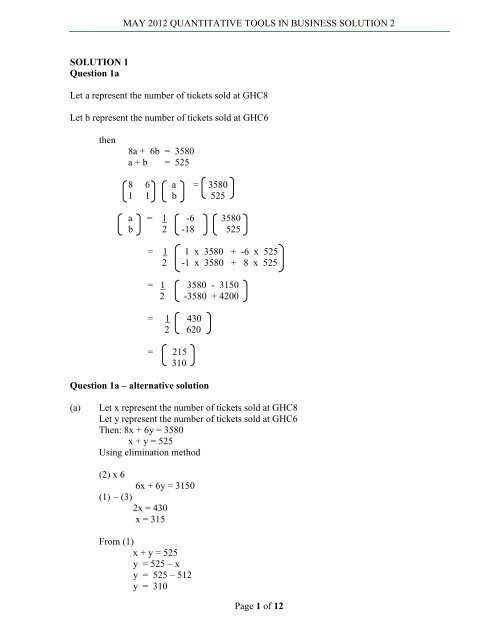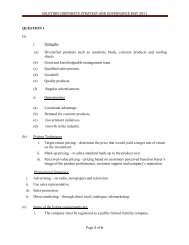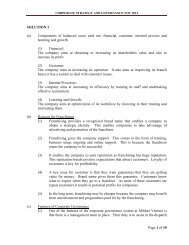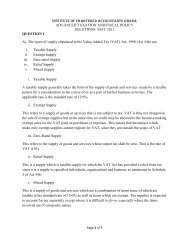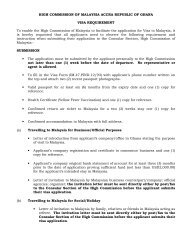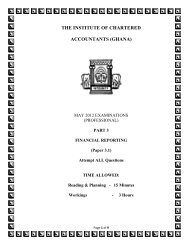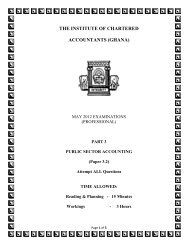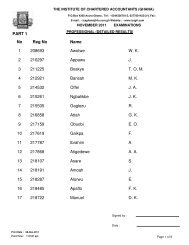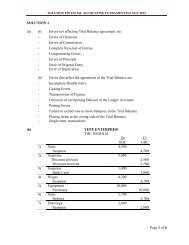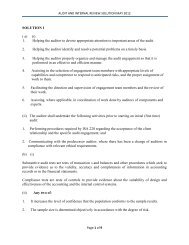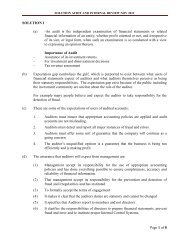quantitative tool in business
quantitative tool in business
quantitative tool in business
Create successful ePaper yourself
Turn your PDF publications into a flip-book with our unique Google optimized e-Paper software.
MAY 2012 QUANTITATIVE TOOLS IN BUSINESS SOLUTION 2(c)Let x be the project durationThen x N (24.3, 1.1553)P (x > 26) = P x – 24.3 > 26 – 24.31.1553 1.1553= P (Ƶ > 1.47)From tables, P(x > 26) = 0.0708(d)From the Gantt Chart the activities that were curtailed are E, H and ISOLUTION 3(a)The problem can be formulated as follows:Max Z = 25x 1 + 20x 2 + 15x 3S.t. 2x 1 + x 2 + 3x 3 ≤ 400 (Skilled Labour)4x 1 + 2x 2 + x 3 ≤ 600 (Leather)6x 1 + 2x 2 + x 3 ≤ 1200 (Glue)x 1 ≤ 100 (Demand for A)x 1 , x 2 , x 3 ≤ 0 (Non negativity)(b)Initial Simplex TableauBasis X1 X2 X3 S1 S2 S3 S4 Constant ……S1S2S3S4246(1)1222311010000100001000014006001200100200150200100Ƶ -25 -20 -15 0 0 0 0 0(c)(d)From the illustration <strong>in</strong> the table above, the <strong>in</strong>crease <strong>in</strong> total revenue is GH¢2500From the f<strong>in</strong>al Simplex Tableau;(i) Production-mix is: x 1 = 100x 2 = 80x 3 = 40(ii)(iii)Maximum total revenue = Max Ƶ = GH¢4900Shadow price for skilled labour = GH¢2/hourPage 4 of 12
MAY 2012 QUANTITATIVE TOOLS IN BUSINESS SOLUTION 2Daily Forecast for next weekDay Trend (T) SA1 Sale figureA(Y/GH¢’00)MonTueWedThurFri3.886 + 3.289 (16) = 56.513.886 + 3.289 (17) = 59.7993.886 + 3.289 (18) = 63.0883.886 + 3.289 (19) = 66.3773.886 + 3.289 (20) = 69.6661.2961.0400.9180.9000.84673.2462.1957.9159.7458.94SOLUTION 5(i) Total Cost (C) = x 2 + 16x + 39Average Cost C = x 2 + 16x + 39X x= x + 16 + 39x(ii) Total Cost (C) = x2 + 16x + 39Marg<strong>in</strong>al Cost = dc = 2x + 16…= 2x + 16(iii) Price (P) = x 2 - 24 x + 117Total Revenue (TR) = Px = x 3 - 24x 2 + 117xTotal Revenue (TR) x 3 – 24x 2 + 117x(iv) Total Revenue (TR) = x 3 – 24x 2 + 117xMarg<strong>in</strong>al Revenue = dTR = 3x 2 - 48x + 117= dx= 3x 2 - 48x + 117x 0 1 2 3 4 5 6 7 8 9 10x + 16 + 39/x 00 56 37.5 32 29.9 28.8 28.5 28.6 28.9 29.3 29.92x + 16 16 18 20 22 24 26 28 30 32 34 36x2 – 48x + 117 117 72 33 0 -27 -48 -63 -72 -75 -72 -63Page 7 of 12
MAY 2012 QUANTITATIVE TOOLS IN BUSINESS SOLUTION 2R = x3 – 24x2 + 117Total Revenue (TR) is maximized where MR = cMR = dTR = 3x 2 – 48x + 117 = 0dx3x 2 – 48x + 117 = 03x 2 – 39x – 9x + 117 = 0(x – 13) (3x – 9) = 0x = 13, x = 3d-TR = dMR = 6x - 48dx 2 dxwhen x = 3, dMR = 18 – 48 = - 30dx:. x = 3 maximumP = x 2 – 24x + 117when x = 3P = 3 2 – 24 (3) + 117 = 54P = x – 24x + 117 (Price function)dP/dx – 2x – 24Elasticity (x = 3) = P . 1/dP/dxx= 54 . 1___3 (2x – 24)= 18 . 1 __ = - 1(6 – 24)Elasticity = - 1(v)Profit is maximized at mc = MRFrom the graph at mc = MRx = 2.35Price (x = 2.35) = (2.35) 2 – 24 (2.35) + 117= 66.1225Elasticity (x = 2.35) = 66.1225 . [1/2 (2.35) – 24)]2.35= 28.137-19.3Elasticity = -1.458Page 8 of 12
MAY 2012 QUANTITATIVE TOOLS IN BUSINESS SOLUTION 2SOLUTION 6Random sampl<strong>in</strong>g is a sampl<strong>in</strong>g technique <strong>in</strong> which all observations have an equal chance tobe<strong>in</strong>g selected. Example: if there are 10 balls <strong>in</strong> a box, the selection of any one of random hasequal chance of 1/10 of be<strong>in</strong>g selected. Their sampl<strong>in</strong>g method is mostly used by Lotteries.Quota sampl<strong>in</strong>g is a sampl<strong>in</strong>g technique where quotas are allotted to identifiable groups and fromeach group selection is made. The groups are homogenous <strong>in</strong> character. Example: if arepresentation is required for a university student’s body, quotas can be given to each universitythen with<strong>in</strong> each group another sampl<strong>in</strong>g method could be used to select the observations. Thistechnique is used by FIFA to select representations for its tournaments.Systematic sampl<strong>in</strong>g is a sampl<strong>in</strong>g technique of select<strong>in</strong>g sample members from a largerpopulation accord<strong>in</strong>g to a random start<strong>in</strong>g po<strong>in</strong>t and a fixed, periodic <strong>in</strong>terval. Typically, every"nth" member is selected from the total population for <strong>in</strong>clusion <strong>in</strong> the sample population.For example, if you wanted to select a random group of 1,000 people from a population of50,000 us<strong>in</strong>g systematic sampl<strong>in</strong>g, you would simply select every 50th person, s<strong>in</strong>ce50,000/1,000 = 50. Another example is select<strong>in</strong>g samples from a production l<strong>in</strong>e where every10 th product can be selected for <strong>in</strong>spection.Frequency Distribution TableYields (kg) Tally Frequency10 – 1415 – 1920 – 2425 – 29|| || | | || | | | |125630 – 34| | | | | | |835 – 39| | | | | | | |940 – 44| | | | | |745 – 4950 – 5455 – 5960 - 64| | | || | || | ||5331__Σf50Page 9 of 12
MAY 2012 QUANTITATIVE TOOLS IN BUSINESS SOLUTION 2(ii)Cumulative Frequency Distribution TableLess than9.5-14.519.524.529.534.539.544.549.554.559.564.5Σf01381422313843464950Frequency TableFields- 14- 19- 24- 29- 34- 39- 445– 492– 545 – 592 - 64Frequency(f)Mid- po<strong>in</strong>t(x)___ fx x 2 fx 21121214414421734289578522110484 2420627162729 4374832256 1024 8192937333 1369 12 321742294 1764 12 348547235 2209 11 045352156 2704 8 112357171 3249 9 747162623844 3 844Σf50 Σfx1825 Σfx 2 73,125Mean (x) = Σfx = 1825 = 36.5 kgΣf 50____________Std deviation = √ Σfx 2 - Σfx2Σf Σf________________= √ 73125 - 1825250 50_______________ ______= √ 1462.5 - 1332.25 = √ 130.25σ= 11.41 kgPage 10 of 12
MAY 2012 QUANTITATIVE TOOLS IN BUSINESS SOLUTION 2From abovemean = 36.5 kg andσ = 11.41 kgInterval with<strong>in</strong> one std deviation of mean= [25.09, 47.91]on the chart, ((41 – 63) = 35) 35 trees…. With<strong>in</strong> x + σ, which is 3552 = 70%SOLUTION 7(a)Let L = {worker comes late}M = {worker is male}P(L/M) = 0.08P(M) = 150 = 0.30500Pr (A male late comer) = P(L∩M)= P(M) P(L/M)= 0.30 x 0.08= 0.24(b)Quarterly Production Levels Matrix:P =Q1 Q2 Q3 Q44000 4500 4500 40002000 2600 2400 22005800 6200 6000 6000ABC(c)Unit Production Costs Matrix:C =A B C100 300 150300 400 250100 200 150Raw materialsLabouroverheadsPage 11 of 12
MAY 2012 QUANTITATIVE TOOLS IN BUSINESS SOLUTION 2The matrix CP gives the quarterly costsi.eCP =100300100300400200150250150400020005800450026006200450024006000400022006000= 185000345000167000216000394000190000207000381000183000196000358000174000Hence the follow<strong>in</strong>g table can be presented at the stockholders’ meet<strong>in</strong>g.QuarterCategory Q1 Q2 Q3 Q4 TotalRaw MaterialLabourOverheads1850003450001670002160003940001900002070003810001830001960003580001740008060001478000714000Total 699000 800000 771000 728000 2998000Page 12 of 12


